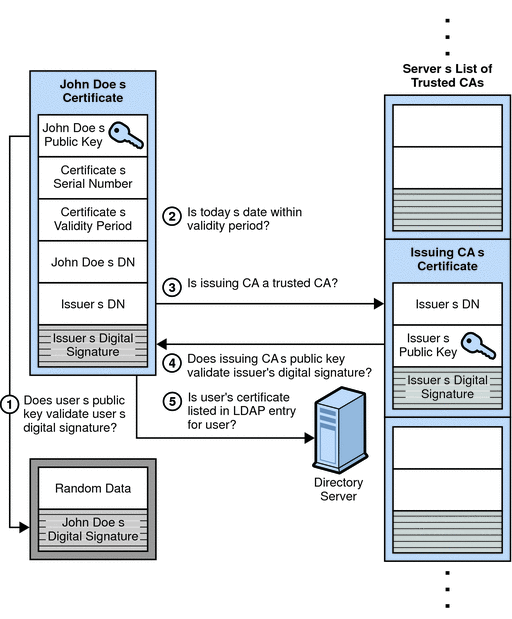Client Authentication During SSL Handshake
SSL-enabled servers can be configured to require client authentication, or cryptographic validation by the server of the client’s identity. When a server configured this way requests client authentication separate piece of digitally signed data to authenticate itself. The server uses the digitally signed data to validate the public key in the certificate and to authenticate the identity the certificate claims to represent.
The SSL protocol requires the client to create a digital signature by creating a one-way hash from data generated randomly during the handshake and known only to the client and server. The hash of the data is then encrypted with the private key that corresponds to the public key in the certificate being presented to the server.
To authenticate the binding between the public key and the person or other entity identified by the certificate that contains the public key, an SSL-enabled server must receive a yes answer to the first four questions shown in Figure 2–10. Although the fifth question is not part of the SSL protocol, directory servers can be configured to support this requirement to take advantage of the user entry in an LDAP directory as part of the authentication process.
Figure 2–10 Authentication and Verification During SSL Handshake

An SSL-enabled server goes through the following steps to authenticate a user’s identity:
-
Does the user’s public key validate the user’s digital signature?
The server checks that the user’s digital signature can be validated with the public key in the certificate. If so, the server has established that the public key asserted to belong to John Doe matches the private key used to create the signature and that the data has not been tampered with since it was signed.
At this point, however, the binding between the public key and the DN specified in the certificate has not yet been established. The certificate might have been created by someone attempting to impersonate the user. To validate the binding between the public key and the DN, the server must also complete steps 3 and 4 in this list.
-
Is today’s date within the validity period?
The server checks the certificate’s validity period. If the current date and time are outside of that range, the authentication process won’t go any further. If the current date and time are within the certificate’s validity period, the server goes onto the next step.
-
Is the issuing CA a trusted CA?
Each SSL-enabled server maintains a list of trusted CA certificates, represented by the shaded area on the right—hand side of Figure 2–10. This list determines which certificates the server accepts. If the DN of the issuing CA matches the DN of a CA on the server’s list of trusted CAs, the answer to this question is yes, and the server goes on to the next step. If the issuing CA is not on the list, the client is not authenticated unless the server can verify a certificate chain ending in a CA that is trusted or not trusted within their organizations by controlling the lists of CA certificates maintained by clients and servers.
-
Does the issuing CA’s public key validate the issuer’s digital signature?
The server uses the public key from the CA’s certificate (which it found in its list of trusted CAs in the previous step) to validate the CA’s digital signature on the certificate being presented. If the information in the certificate has changed since it was signed by the CA or if the public key in the CA certificate doesn’t correspond to the private key used by the CA to sign the certificate, the server won’t authenticate the user’s identity. If the CA’s digital signature can be validated, the server treats the user’s certificate as a valid “letter of introduction” from that CA and proceeds. At this point, the SSL protocol allows the server to consider the client authenticated and proceed with the connection as described in step 6. The directory servers may optionally be configured to perform step 5 before step 6.
-
Is the user’s certificate listed in the LDAP entry for the user?
This optional step provides one way for a system administrator to revoke a user’s certificate even if it passes the tests in all the other steps. The Certificate Management System can automatically remove a revoked certificate from the user’s entry in the LDAP directory. All servers that are set up to perform this step then refuses to authenticate that certificate or establish a connection. If the user’s certificate in the directory is identical to the user’s certificate presented in the SSL handshake, the server goes on to the next step.
-
Is the authenticated client authorized to access the requested resources?
The server checks what resources the client is permitted to access according to the server’s access control lists (ACLs) and establishes a connection with appropriate access. If the server doesn’t get to step 6 for any reason, the user identified by the certificate cannot be authenticated, and the user is not allowed to access any server resources that require authentication.
- © 2010, Oracle Corporation and/or its affiliates
